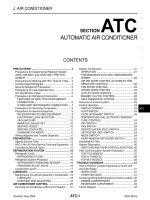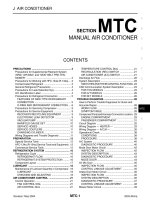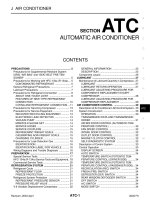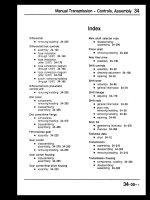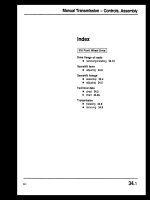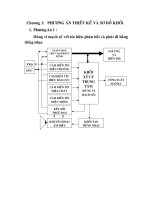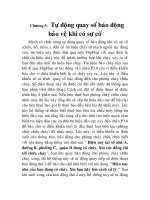ATC hệ THỐNG điều KHIỂN hộp số tự ĐỘNG TRÊN INFINITI FX35, FX45 2003
Bạn đang xem bản rút gọn của tài liệu. Xem và tải ngay bản đầy đủ của tài liệu tại đây (5 MB, 174 trang )
ATC-1
AUTOMATIC AIR CONDITIONER
J AIR CONDITIONER
CONTENTS
C
D
E
F
G
H
I
K
L
M
SECTION ATC
A
B
ATC
Revision; 2004 April 2003 FX
AUTOMATIC AIR CONDITIONER
PRECAUTIONS 5
Precautions for Supplemental Restraint System
(SRS) “AIR BAG” and “SEAT BELT PRE-TEN-
SIONER” 5
Precautions for Working with HFC-134a (R-134a) 5
CONTAMINATED REFRIGERANT 5
General Refrigerant Precautions 7
Lubricant Precautions 7
Precautions for Refrigerant Connection 8
ABOUT ONE-TOUCH JOINT 8
FEATURES OF NEW TYPE REFRIGERANT
CONNECTION 10
O-RING AND REFRIGERANT CONNECTION 11
Precautions for Servicing Compressor 13
Precautions for Service Equipment 13
RECOVERY/RECYCLING EQUIPMENT 13
ELECTRONIC LEAK DETECTOR 13
VACUUM PUMP 14
MANIFOLD GAUGE SET 14
SERVICE HOSES 14
SERVICE COUPLERS 15
REFRIGERANT WEIGHT SCALE 15
CALIBRATING ACR4 WEIGHT SCALE 15
CHARGING CYLINDER 15
Precautions for Leak Detection Dye 16
IDENTIFICATION 16
IDENTIFICATION LABEL FOR VEHICLE 16
Wiring Diagrams and Trouble Diagnosis 16
PREPARATION 17
Special Service Tools 17
HFC-134a (R-134a) Service Tools and Equipment 18
Commercial Service Tools 20
REFRIGERATION SYSTEM 21
Refrigerant Cycle 21
REFRIGERANT FLOW 21
FREEZE PROTECTION 21
Refrigerant System Protection 21
REFRIGERANT PRESSURE SENSOR 21
PRESSURE RELIEF VALVE 21
V-6 Variable Displacement Compressor 22
GENERAL INFORMATION 22
DESCRIPTION 23
Component Layout 26
LUBRICANT 27
Maintenance of Lubricant Quantity in Compressor 27
LUBRICANT 27
LUBRICANT RETURN OPERATION 27
LUBRICANT ADJUSTING PROCEDURE FOR
COMPONENTS REPLACEMENT EXCEPT
COMPRESSOR 28
LUBRICANT ADJUSTING PROCEDURE FOR
COMPRESSOR REPLACEMENT 29
AIR CONDITIONER CONTROL 30
Description of Air Conditioner LAN Control System 30
System Construction 30
OPERATION 30
TRANSMISSION DATA AND TRANSMISSION
ORDER 31
AIR MIX DOOR CONTROL (AUTOMATIC TEM-
PERATURE CONTROL) 32
FAN SPEED CONTROL 32
INTAKE DOOR CONTROL 32
OUTLET DOOR CONTROL 32
MAGNET CLUTCH CONTROL 32
SELF-DIAGNOSTIC SYSTEM 32
Description of Control System 33
Control Operation 33
DISPLAY SCREEN 34
AUTO SWITCH 34
TEMPERATURE SWITCH (POTENTIO TEM-
PERATURE CONTROL) (DRIVER SIDE) 34
TEMPERATURE SWITCH (POTENTIO TEM-
PERATURE CONTROL) (PASSENGER SIDE) 34
RECIRCULATION (REC) SWITCH 34
FRESH (FRE) SWITCH 34
DEFROSTER (DEF) SWITCH 34
REAR WINDOW DEFOGGER SWITCH 34
OFF SWITCH 34
A/C SWITCH 34
MODE SWITCH 34
ATC-2
Revision; 2004 April 2003 FX
FAN SWITCH 34
DUAL SWITCH (WITH LEFT AND RIGHT VEN-
TILATION TEMPERATURE SEPARATELY
CONTROL SYSTEM) 34
Fail-safe Function 35
Discharge Air Flow 36
System Description 37
SWITCHES AND THEIR CONTROL FUNCTION 37
CAN Communication System Description 38
CAN Communication Unit 38
TYPE 1/TYPE2 39
TYPE 3 42
TYPE 4/TYPE5 45
TYPE 6 48
TROUBLE DIAGNOSIS 52
CONSULT-II 52
CONSULT-II BASIC OPERATION 52
DATA MONITOR 53
How to Perform Trouble Diagnosis for Quick and
Accurate Repair 54
WORK FLOW 54
SYMPTOM TABLE 54
Component Parts and Harness Connector Location 56
ENGINE COMPARTMENT 56
PASSENGER COMPARTMENT 57
Schematic 58
Wiring Diagram —A/C— 59
Auto Amp. Terminals and Reference Value 64
PIN CONNECTOR TERMINAL LAYOUT 64
TERMINALS AND REFERENCE VALUE FOR
UNIFIED METER AND A/C AMP. 64
Self-diagnosis Function 66
DESCRIPTION 66
FUNCTION CONFIRMATION PROCEDURE 67
AUXILIARY MECHANISM: TEMPERATURE
SETTING TRIMMER 73
AUXILIARY MECHANISM: FOOT POSITION
SETTING TRIMMER 74
AUXILIARY MECHANISM: INLET PORT MEM-
ORY FUNCTION 74
Operational Check 75
CHECKING MEMORY FUNCTION 75
CHECKING BLOWER 75
CHECKING DISCHARGE AIR 75
CHECKING RECIRCULATION 76
CHECKING TEMPERATURE DECREASE 76
CHECKING TEMPERATURE INCREASE 76
CHECK A/C SWITCH 76
CHECKING AUTO MODE 77
Power Supply and Ground Circuit for Auto Amp. 77
INSPECTION FLOW 77
COMPONENT DESCRIPTION 78
DIAGNOSTIC PROCEDURE FOR A/C SYSTEM 78
LAN System Circuit 80
DIAGNOSTIC PROCEDURE FOR LAN CIR-
CUIT 80
Mode Door Motor Circuit 83
INSPECTION FLOW 83
SYSTEM DESCRIPTION 84
COMPONENT DESCRIPTION 85
DIAGNOSTIC PROCEDURE FOR MODE
DOOR MOTOR 85
Air Mix Door Motor Circuit 86
INSPECTION FLOW 86
SYSTEM DESCRIPTION 87
COMPONENT DESCRIPTION 88
DIAGNOSTIC PROCEDURE FOR AIR MIX
DOOR 88
Air Mix Door Motor PBR Circuit 88
DIAGNOSTIC PROCEDURE FOR AIR MIX
DOOR PBR 88
Intake Door Motor Circuit 89
INSPECTION FLOW 89
SYSTEM DESCRIPTION 90
COMPONENT DESCRIPTION 91
DIAGNOSTIC PROCEDURE FOR INTAKE
DOOR MOTOR 91
Blower Motor Circuit 92
INSPECTION FLOW 92
SYSTEM DESCRIPTION 93
COMPONENT DESCRIPTION 94
DIAGNOSTIC PROCEDURE FOR BLOWER
MOTOR 94
COMPONENT INSPECTION 97
Magnet Clutch Circuit 98
INSPECTION FLOW 98
SYSTEM DESCRIPTION 99
DIAGNOSTIC PROCEDURE FOR MAGNET
CLUTCH 99
COMPONENT INSPECTION 103
Insufficient Cooling 104
INSPECTION FLOW 104
PERFORMANCE TEST DIAGNOSES 105
PERFORMANCE CHART 107
TROUBLE DIAGNOSIS FOR UNUSUAL PRES-
SURE 108
DIAGNOSTIC PROCEDURE FOR INSUFFI-
CIENT COOLING 110
Insufficient Heating 112
INSPECTION FLOW 112
Noise 113
INSPECTION FLOW 113
Self-diagnosis 114
INSPECTION FLOW 114
Memory Function 115
INSPECTION FLOW 115
Ambient Sensor Circuit 116
COMPONENT DESCRIPTION 116
AMBIENT TEMPERATURE INPUT PROCESS .116
DIAGNOSTIC PROCEDURE FOR AMBIENT
SENSOR 116
COMPONENT INSPECTION 118
In-vehicle Sensor Circuit 119
COMPONENT DESCRIPTION 119
DIAGNOSTIC PROCEDURE FOR IN-VEHICLE
SENSOR 120
COMPONENT INSPECTION 121
Sunload Sensor Circuit 122
ATC-3
C
D
E
F
G
H
I
K
L
M
A
B
ATC
Revision; 2004 April 2003 FX
COMPONENT DESCRIPTION 122
SUNLOAD INPUT PROCESS 122
DIAGNOSTIC PROCEDURE FOR SUNLOAD
SENSOR 122
COMPONENT INSPECTION 124
Intake Sensor Circuit 125
COMPONENT DESCRIPTION 125
DIAGNOSTIC PROCEDURE FOR INTAKE SEN-
SOR 125
COMPONENT INSPECTION 126
CONTROLLER 127
Removal and Installation of A/C and AV Switch 127
REMOVAL 127
INSTALLATION 127
AUTO AMP 128
Removal and Installation of Unified Meter and A/C
Amp. 128
REMOVAL 128
INSTALLATION 128
AMBIENT SENSOR 129
Removal and Installation 129
REMOVAL 129
INSTALLATION 129
IN-VEHICLE SENSOR 130
Removal and Installation 130
REMOVAL 130
INSTALLATION 130
SUNLOAD SENSOR 131
Removal and Installation 131
REMOVAL 131
INSTALLATION 131
INTAKE SENSOR 132
Removal and Installation 132
REMOVAL 132
INSTALLATION 133
BLOWER UNIT 134
Removal and Installation 134
REMOVAL 134
INSTALLATION 134
Disassembly and Assembly 135
BLOWER MOTOR 136
Removal and Installation 136
REMOVAL 136
INSTALLATION 136
INTAKE DOOR MOTOR 137
Removal and Installation 137
REMOVAL 137
INSTALLATION 137
HEATER & COOLING UNIT ASSEMBLY 138
Removal and Installation 138
REMOVAL 138
INSTALLATION 139
Disassembly and Assembly 140
MODE DOOR MOTOR 142
Removal and Installation 142
REMOVAL 142
INSTALLATION 142
AIR MIX DOOR MOTOR 143
Removal and Installation 143
REMOVAL 143
INSTALLATION 143
HEATER CORE 144
Removal and Installation 144
REMOVAL 144
INSTALLATION 144
DUCTS AND GRILLES 145
Removal and Installation 145
REMOVAL 145
INSTALLATION 148
REFRIGERANT LINES 149
HFC-134a (R-134a) Service Procedure 149
SETTING OF SERVICE TOOLS AND EQUIP-
MENT 149
Components 151
VK45DE 151
VQ35DE 152
Removal and Installation of Compressor 152
REMOVAL 152
INSTALLATION 154
Removal and Installation of Compressor Clutch 155
REMOVAL 155
INSTALLATION 157
Removal and Installation of Low-pressure Flexible
Hose 159
REMOVAL 159
INSTALLATION 160
Removal and Installation of High-pressure Flexible
Hose 160
REMOVAL 160
INSTALLATION 161
Removal and Installation of Low-pressure Pipe 1
(Engine Compartment) 161
REMOVAL 161
INSTALLATION 162
Removal and Installation of High-pressure Pipe 1
and 2 (Engine Compartment) 162
REMOVAL 162
INSTALLATION 163
Removal and Installation of Low-pressure Pipe 2
and High-pressure Pipe 3 163
REMOVAL 163
INSTALLATION 164
Removal and Installation of Liquid Tank 165
REMOVAL 165
INSTALLATION 165
Removal and Installation of Condenser 166
REMOVAL 166
INSTALLATION 166
Removal and Installation of Refrigerant Pressure
Sensor 167
REMOVAL 167
INSTALLATION 167
Removal and Installation of Evaporator 167
REMOVAL 167
INSTALLATION 167
Removal and Installation of Expansion Valve 169
ATC-4
Revision; 2004 April 2003 FX
REMOVAL 169
INSTALLATION 169
Checking for Refrigerant Leaks 170
Checking System for Leaks Using the Fluorescent
Leak Detector 170
Dye Injection 170
Electronic Refrigerant Leak Detector 171
PRECAUTIONS FOR HANDLING LEAK
DETECTOR 171
CHECKING PROCEDURE 172
SERVICE DATA AND SPECIFICATIONS (SDS) 174
Compressor 174
Lubricant 174
Refrigerant 174
Engine Idling Speed 174
Belt Tension 174
PRECAUTIONS
ATC-5
C
D
E
F
G
H
I
K
L
M
A
B
ATC
Revision; 2004 April 2003 FX
PRECAUTIONS PFP:00001
Precautions for Supplemental Restraint System (SRS) “AIR BAG” and “SEAT
BELT PRE-TENSIONER”
AJS001BM
The Supplemental Restraint System such as “AIR BAG” and “SEAT BELT PRE-TENSIONER”, used along
with a front seat belt, helps to reduce the risk or severity of injury to the driver and front passenger for certain
types of collision. This system includes seat belt switch inputs and dual stage front air bag modules. The SRS
system uses the seat belt switches to determine the front air bag deployment, and may only deploy one front
air bag, depending on the severity of a collision and whether the front occupants are belted or unbelted.
Information necessary to service the system safely is included in the SRS and SB section of this Service Man-
ual.
WARNING:
● To avoid rendering the SRS inoperative, which could increase the risk of personal injury or death
in the event of a collision which would result in air bag inflation, all maintenance must be per-
formed by an authorized NISSAN/INFINITI dealer.
● Improper maintenance, including incorrect removal and installation of the SRS, can lead to per-
sonal injury caused by unintentional activation of the system. For removal of Spiral Cable and Air
Bag Module, see the SRS section.
● Do not use electrical test equipment on any circuit related to the SRS unless instructed to in this
Service Manual. SRS wiring harnesses can be identified by yellow and/or orange harnesses or
harness connectors.
Precautions for Working with HFC-134a (R-134a) AJS0013V
WARNING:
● CFC-12 (R-12) refrigerant and HFC-134a (R-134a) refrigerant are not compatible. If the refrigerants
are mixed and compressor malfunction is likely to occur, refer to “CONTAMINATED REFRIGER-
ANT” below. To determine the purity of HFC-134a (R-134a) in the vehicle and recovery tank, use
Refrigerant Recovery/Recycling Recharging equipment (ACR4) (J-39500-INF) and Refrigerant
Identifier.
● Use only specified lubricant for the HFC-134a (R-134a) A/C system and HFC-134a (R-134a) compo-
nents. If lubricant other than that specified is used, compressor malfunction is likely to occur.
● The specified HFC-134a (R-134a) lubricant rapidly absorbs moisture from the atmosphere. The fol-
lowing handling precautions must be observed:
– When removing refrigerant components from a vehicle, immediately cap (seal) the component to
minimize the entry of moisture from the atmosphere.
– When installing refrigerant components to a vehicle, do not remove the caps (unseal) until just
before connecting the components. Connect all refrigerant loop components as quickly as possi-
ble to minimize the entry of moisture into system.
– Only use the specified lubricant from a sealed container. Immediately reseal containers of lubri-
cant. Without proper sealing, lubricant will become moisture saturated and should not be used.
– Avoid breathing A/C refrigerant and lubricant vapor or mist. Exposure may irritate eyes, nose and
throat. Remove HFC-134a (R-134a) from the A/C system, using certified service equipment meet-
ing requirements of SAE J2210 [HFC-134a (R-134a) recycling equipment], or J2209 [HFC-134a (R-
134a) recovery equipment]. If accidental system discharge occurs, ventilate work area before
resuming service. Additional health and safety information may be obtained from refrigerant and
lubricant manufacturers.
– Do not allow lubricant (Nissan A/C System Oil Type S) to come in contact with styrofoam parts.
Damage may result.
CONTAMINATED REFRIGERANT
If a refrigerant other than pure HFC-134a ( R-134a) is identified in a vehicle, your options are:
● Explain to the customer that environmental regulations prohibit the release of contaminated refrigerant
into the atmosphere.
● Explain that recovery of the contaminated refrigerant could damage your service equipment and refriger-
ant supply.
● Suggest the customer return the vehicle to the location of previous service where the contamination may
have occurred.
ATC-6
PRECAUTIONS
Revision; 2004 April 2003 FX
● If you choose to perform the repair, recover the refrigerant using only dedicated equipment and contain-
ers. Do not recover contaminated refrigerant into your existing service equipment. If your facility
does not have dedicated recovery equipment, you may contact a local refrigerant product retailer for avail-
able service. This refrigerant must be disposed of in accordance with all federal and local regulations. In
addition, replacement of all refrigerant system components on the vehicle is recommended.
● If the vehicle is within the warranty period, the air conditioner warranty is void. Please contact Nissan Cus-
tomer Affairs for further assistance.
PRECAUTIONS
ATC-7
C
D
E
F
G
H
I
K
L
M
A
B
ATC
Revision; 2004 April 2003 FX
General Refrigerant Precautions AJS0013W
WARNING:
● Do not release refrigerant into the air. Use approved recovery/recycling equipment to capture the
refrigerant every time an air conditioning system is discharged.
● Always wear eye and hand protection (goggles and gloves) when working with any refrigerant or
air conditioning system.
● Do not store or heat refrigerant containers above 52°C (125°F).
● Do not heat a refrigerant container with an open flame; if container warming is required, place the
bottom of the container in a warm pail of water.
● Do not intentionally drop, puncture, or incinerate refrigerant containers.
● Keep refrigerant away from open flames: poisonous gas will be produced if refrigerant burns.
● Refrigerant will displace oxygen, therefore be certain to work in well ventilated areas to prevent
suffocation.
● Do not pressure test or leak test HFC-134a (R-134a) service equipment and/or vehicle air condi-
tioning systems with compressed air during repair. Some mixtures of air and HFC-134a (R-134a)
have been shown to be combustible at elevated pressures. These mixtures, if ignited, may cause
injury or property damage. Additional health and safety information may be obtained from refriger-
ant manufacturers.
Lubricant Precautions AJS0013X
● Use only specified lubricant for the HFC-134a (R-134a) A/C system and HFC-134a (R-134a) components.
If lubricant other than that specified is used, compressor malfunction is likely to occur.
● The specified HFC-134a (R-134a) lubricant rapidly absorbs moisture from the atmosphere. The following
handling precautions must be observed:
– When removing refrigerant components from a vehicle, immediately cap (seal) the component to minimize
the entry of moisture from the atmosphere.
– When installing refrigerant components to a vehicle, do not remove the caps (unseal) until just before con-
necting the components. Connect all refrigerant loop components as quickly as possible to minimize the
entry of moisture into system.
– Only use the specified lubricant from a sealed container. Immediately reseal containers of lubricant. With-
out proper sealing, lubricant will become moisture saturated and should not be used.
● Avoid breathing A/C refrigerant and lubricant vapor or mist. Exposure may irritate eyes, nose and throat.
Remove HFC-134a (R-134a) from the A/C system, using certified service equipment meeting require-
ments of SAE J2210 [HFC-134a (R-134a) recycling equipment], or J2209 [HFC-134a (R-134a) recovery
equipment]. If accidental system discharge occurs, ventilate work area before resuming service. Addi-
tional health and safety information may be obtained from refrigerant and lubricant manufacturers.
● Do not allow lubricant (Nissan A/C System Oil Type S) to come in contact with styrofoam parts. Damage
may result.
ATC-8
PRECAUTIONS
Revision; 2004 April 2003 FX
Precautions for Refrigerant Connection AJS0013Y
A new type refrigerant connection has been introduced to all refrigerant lines except the following location.
● Expansion valve to evaporator
● Refrigerant pressure sensor to condenser
ABOUT ONE-TOUCH JOINT
Description
● One-touch joints are pipe joints which do not require tools during piping connection.
● Unlike conventional connection methods using union nuts and flanges, controlling tightening torque at
connection point is not necessary.
● When removing a pipe joint, use a disconnector.
COMPONENT PARTS
FUNCTIONS OF COMPONENT PARTS
NOTE:
● Garter spring cannot be removed from cage of male-side piping.
● Indicator ring remains near piping connection point, however, this is not a malfunction. (This is to check
piping connection during factory assembly.)
Pipe (Male side)
● Retains O-rings.
● Retains garter spring in cage.
Garter spring Anchors female side piping.
Indicator ring
When connection is made properly, this is ejected from male-side piping. (This part is no longer neces-
sary after connection.)
O-ring Seals connection point. (Not reusable)
Pipe (Female side)
● Seals connection by compressing O-rings.
● Anchors piping connection using flare and garter spring.
RJIA0970E
PRECAUTIONS
ATC-9
C
D
E
F
G
H
I
K
L
M
A
B
ATC
Revision; 2004 April 2003 FX
REMOVAL
1. Clean piping connection point, and set a disconnector.
2. Slide disconnector in axial direction of piping, and stretch garter spring with tapered point of disconnector.
3. Slide disconnector farther so that inside diameter of garter spring becomes larger than outside diameter of
female-side piping flare. Then male-side piping can be disconnected.
INSTALLATION
1. Clean piping connection points, and insert male-side piping into female-side piping.
2. Push inserted male-side piping harder so that female-side piping flare stretches garter spring.
3. If inside diameter of garter spring becomes larger than outside diameter of female-side piping flare, garter
spring seats on flare. Then, it fits in between male-side piping cage and female-side piping flare to anchor
piping connection point.
NOTICE:
When garter spring seats on flare, and fits in between male-side piping cage and female-side piping flare,
it clicks.
CAUTION:
● Female-side piping connection point is thin. So, when inserting male-side piping, take care not
to deform female-side piping. Slowly insert it in axial direction.
● Insert piping securely until a click is heard.
SJIA0106E
SJIA0107E
ATC-10
PRECAUTIONS
Revision; 2004 April 2003 FX
● After piping connection is completed, pull male-side piping by hand to make sure connection
does not come loose.
NOTE:
One-touch joint connection is used in points below.
● Low-pressure pipe 1 to low-pressure pipe 2 (O-ring size: 16)
● High-pressure pipe 1 to high-pressure pipe 2 (O-ring size: 8)
● High-pressure pipe 2 to high-pressure pipe 3 (O-ring size: 8)
● Low-pressure flexible hose to low-pressure pipe 1 (O-ring size: 16)
● Condenser to high-pressure flexible hose (O-ring size: 12)
● Condenser to high-pressure pipe 1 (O-ring size: 8)
FEATURES OF NEW TYPE REFRIGERANT CONNECTION
● The O-ring has been relocated. It has also been provided with a groove for proper installation. This elimi-
nates the chance of the O-ring being caught in, or damaged by, the mating part. The sealing direction of
the O-ring is now set vertically in relation to the contacting surface of the mating part to improve sealing
characteristics.
● The reaction force of the O-ring will not occur in the direction that causes the joint to pull out, thereby facil-
itating piping connections.
SHA815E
PRECAUTIONS
ATC-11
C
D
E
F
G
H
I
K
L
M
A
B
ATC
Revision; 2004 April 2003 FX
O-RING AND REFRIGERANT CONNECTION
VK45DE
VQ35DE
RJIA1954E
RJIA1955E
ATC-12
PRECAUTIONS
Revision; 2004 April 2003 FX
CAUTION:
The new and former refrigerant connections use different O-ring configurations. Do not confuse O-
rings since they are not interchangeable. If a wrong O-ring is installed, refrigerant will leak at, or
around, the connection.
O-Ring Part Numbers and Specifications
WARNING:
Make sure all refrigerant is discharged into the recycling equipment and the pressure in the system is
less than atmospheric pressure. Then gradually loosen the discharge side hose fitting and remove it.
CAUTION:
When replacing or cleaning refrigerant cycle components, observe the following.
● When the compressor is removed, store it in the same position as it is when mounted on the car.
Malfunction to do so will cause lubricant to enter the low-pressure chamber.
● When connecting tubes, always use a torque wrench and a back-up wrench.
● After disconnecting tubes, immediately plug all openings to prevent entry of dirt and moisture.
● When installing an air conditioner in the vehicle, connect the pipes as the final stage of the opera-
tion. Do not remove the seal caps of pipes and other components until just before required for
connection.
● Allow components stored in cool areas to warm to working area temperature before removing seal
caps. This prevents condensation from forming inside A/C components.
● Thoroughly remove moisture from the refrigeration system before charging the refrigerant.
● Always replace used O-rings.
● When connecting tube, apply lubricant to circle of the O-rings shown in illustration. Be careful not
to apply lubricant to threaded portion.
Lubricant name: Nissan A/C System Oil Type S
Part number: KLH00-PAGS0
● O-ring must be closely attached to dented portion of tube.
● When replacing the O-ring, be careful not to damage O-ring and tube.
● Connect tube until you hear it click, then tighten the nut or bolt by hand until snug. Make sure that
the O-ring is installed to tube correctly.
Connection type Piping connection point Part number QTY O-ring size
New
Low-pressure pipe 1 to low-pressure pipe 2 (One-touch joint) 92473 N8221 2 16
Low-pressure pipe 2 to expansion valve 92473 N8210 1 16
High-pressure pipe 1 to high-pressure pipe 2 (One-touch joint) 92471 N8221 2 8
High-pressure pipe 3 to expansion valve 92471 N8210 1 8
High-pressure pipe 2 to high-pressure pipe 3 (One-touch joint) 92471 N8221 2 8
Condenser to high-pressure flexible hose (One-touch joint) 92472 N8221 2 12
Condenser to high-pressure pipe 1 (One-touch joint) 92471 N8221 2 8
Low-pressure flexible hose to low-pressure pipe 1 (One-touch
joint)
92473 N8221 2 16
Compressor to low-pressure flexible hose 92474 N8210 1 19
Compressor to high-pressure flexible hose 92472 N8210 1 12
Liquid tank to condenser pipe
Inlet
92471 N8210
1
8
Outlet 1
Former
Refrigerant pressure sensor to condenser J2476 89956 1 10
Expansion valve to evaporator
Inlet 92475 71L00 1 12
Outlet 92475 72L00 1 16
PRECAUTIONS
ATC-13
C
D
E
F
G
H
I
K
L
M
A
B
ATC
Revision; 2004 April 2003 FX
● After connecting line, perform leak test and make sure that there is no leakage from connections.
When the gas leaking point is found, disconnect that line and replace the O-ring. Then tighten con-
nections of seal seat to the specified torque.
Precautions for Servicing Compressor AJS0013Z
● Plug all openings to prevent moisture and foreign matter from entering.
● When the compressor is removed, store it in the same position as it is when mounted on the car.
● When replacing or repairing compressor, follow “Maintenance of Lubricant Quantity in Compres-
sor” exactly. Refer to ATC-27, "
Maintenance of Lubricant Quantity in Compressor" .
● Keep friction surfaces between clutch and pulley clean. If the surface is contaminated, with lubri-
cant, wipe it off by using a clean waste cloth moistened with thinner.
● After compressor service operation, turn the compressor shaft by hand more than five turns in
both directions. This will equally distribute lubricant inside the compressor. After the compressor
is installed, let the engine idle and operate the compressor for one hour.
● After replacing the compressor magnet clutch, apply voltage to the new one and check for usual
operation.
Precautions for Service Equipment AJS00140
RECOVERY/RECYCLING EQUIPMENT
Be certain to follow the manufacturers instructions for machine operation and machine maintenance. Never
introduce any refrigerant other than that specified into the machine.
ELECTRONIC LEAK DETECTOR
Be certain to follow the manufacturer′s instructions for tester operation and tester maintenance.
RHA861F
ATC-14
PRECAUTIONS
Revision; 2004 April 2003 FX
VACUUM PUMP
The lubricant contained inside the vacuum pump is not compatible
with the specified lubricant for HFC-134a (R-134a) A/C systems.
The vent side of the vacuum pump is exposed to atmospheric pres-
sure. So the vacuum pump lubricant may migrate out of the pump
into the service hose. This is possible when the pump is switched off
after evacuation (vacuuming) and hose is connected to it.
To prevent this migration, use a manual valve placed near the hose-
to-pump connection, as follows.
● Usually vacuum pumps have a manual isolator valve as part of
the pump. Close this valve to isolate the service hose from the
pump.
● For pumps without an isolator, use a hose equipped with a man-
ual shut-off valve near the pump end. Close the valve to isolate
the hose from the pump.
● If the hose has an automatic shut-off valve, disconnect the hose
from the pump. As long as the hose is connected, the valve is
open and lubricating oil may migrate.
Some one-way valves open when vacuum is applied and close
under a no vacuum condition. Such valves may restrict the pump′s
ability to pull a deep vacuum and are not recommended.
MANIFOLD GAUGE SET
Be certain that the gauge face indicates HFC-134a (R-134a or
134a). Be sure the gauge set has 1/2″-16 ACME threaded connec-
tions for service hoses. Confirm the set has been used only with
refrigerant HFC-134a (R-134a) and specified lubricants.
SERVICE HOSES
Be certain that the service hoses display the markings described
(colored hose with black stripe). All hoses must include positive shut
-off devices (either manual or automatic) near the end of the hoses
opposite the manifold gauge.
RHA270DA
SHA533D
RHA272D
PRECAUTIONS
ATC-15
C
D
E
F
G
H
I
K
L
M
A
B
ATC
Revision; 2004 April 2003 FX
SERVICE COUPLERS
Never attempt to connect HFC-134a (R-134a) service couplers to an
CFC-12 (R-12) A/C system. The HFC-134a (R-134a) couplers will
not properly connect to the CFC-12 (R-12) system. However, if an
improper connection is attempted, discharging and contamination
may occur.
REFRIGERANT WEIGHT SCALE
Verify that no refrigerant other than HFC-134a (R-134a) and speci-
fied lubricants have been used with the scale. If the scale controls
refrigerant flow electronically, the hose fitting must be 1/2
″
-16
ACME.
CALIBRATING ACR4 WEIGHT SCALE
Calibrate the scale every three months.
To calibrate the weight scale on the ACR4 (J-39500-INF):
1. Press Shift/Reset and Enter at the same time.
2. Press 8787 . “A1 ” will be displayed.
3. Remove all weight from the scale.
4. Press 0 , then press Enter . “0.00 ” will be displayed and change to “A2 ”.
5. Place a known weight (dumbbell or similar weight), between 4.5 and 8.6 kg (10 and 19 lb.) on the center
of the weight scale.
6. Enter the known weight using four digits. (Example 10 lb. = 10.00, 10.5 lb. = 10.50)
7. Press Enter — the display returns to the vacuum mode.
8. Press Shift/Reset and Enter at the same time.
9. Press 6 — the known weight on the scale is displayed.
10. Remove the known weight from the scale. “0.00 ” will be displayed.
11. Press Shift/Reset to return the ACR4 to the program mode.
CHARGING CYLINDER
Using a charging cylinder is not recommended. Refrigerant may be vented into air from cylinder′s top valve
when filling the cylinder with refrigerant. Also, the accuracy of the cylinder is generally less than that of an
electronic scale or of quality recycle/recharge equipment.
Shut-off valve rotation A/C service valve
Clockwise Open
Counterclockwise Close
RHA273D
RHA274D
ATC-16
PRECAUTIONS
Revision; 2004 April 2003 FX
Precautions for Leak Detection Dye AJS00141
● The A/C system contains a fluorescent leak detection dye used for locating refrigerant leaks. An ultraviolet
(UV) lamp is required to illuminate the dye when inspecting for leaks.
● Always wear fluorescence enhancing UV safety goggles to protect your eyes and enhance the visibility of
the fluorescent dye.
● The fluorescent dye leak detector is not a replacement for an electronic refrigerant leak detector. The fluo-
rescent dye leak detector should be used in conjunction with an electronic refrigerant leak detector to (J-
41995) pin-point refrigerant leaks.
● For your safety and your customer′s satisfaction, read and follow all manufacture′s operating instructions
and precautions prior to performing the work.
● A compressor shaft seal should not be repaired because of dye seepage. The compressor shaft seal
should only be repaired after confirming the leak with an electronic refrigerant leak detector (J-41995).
● Always remove any remaining dye from the leak area after repairs are complete to avoid a misdiagnosis
during a future service.
● Do not allow dye to come into contact with painted body panels or interior components. If dye is spilled,
clean immediately with the approved dye cleaner. Fluorescent dye left on a surface for an extended period
of time cannot be removed.
● Do not spray the fluorescent dye cleaning agent on hot surfaces (engine exhaust manifold, etc.).
● Do not use more than one refrigerant dye bottle (1/4 ounce /7.4 cc) per A/C system.
● Leak detection dyes for HFC-134a (R-134a) and CFC-12 (R-12) A/C systems are different. Do not use
HFC-134a (R-134a) leak detection dye in CFC-12 (R-12) A/C system or CFC-12 (R-12) leak detector dye
in HFC-134a (R-134a) A/C systems or A/C system damage may result.
● The fluorescent properties of the dye will remain for over three (3) years unless a compressor malfunction
occurs.
IDENTIFICATION
NOTE:
Vehicles with factory installed fluorescent dye have a green label.
Vehicles without factory installed fluorescent dye have a blue label.
IDENTIFICATION LABEL FOR VEHICLE
Vehicles with factory installed fluorescent dye have this identification
label on the front side of hood.
Wiring Diagrams and Trouble Diagnosis AJS00142
When you read wiring diagrams, refer to the following:
● GI-15, "How to Read Wiring Diagrams" in GI section.
● PG-4, "Wiring Diagram - POWER -" in PG section.
When you perform trouble diagnosis, refer to the following:
● GI-11, "How to Follow Trouble Diagnoses" in GI section.
● GI-27, "How to Perform Efficient Diagnosis for an Electrical Incident" in GI section.
SHA436FA
PREPARATION
ATC-17
C
D
E
F
G
H
I
K
L
M
A
B
ATC
Revision; 2004 April 2003 FX
PREPARATION PFP:00002
Special Service Tools AJS00143
The actual shapes of Kent-Moore tools may differ from those of special service tools illustrated here.
Tool number
(Kent-Moore No.)
Tool name
Description
KV99106100
(J-41260)
Clutch disc wrench
Removing shaft nut and clutch disc
KV99232340
(J-38874)
or
KV992T0001
( - )
Clutch disc puller
Removing clutch disc
KV99106200
(J-41261)
Pulley installer
Installing pulley
92530 89908 (for high-pressure
pipe 1)
( - )
92530 89912 (for high-pressure
flexible hose)
( - )
92530 89916 (for low-pressure
pipe 1 and low-pressure flexible
hose)
( - )
Disconnector tool set
(J-45815)
Disconnect one-touch joint connection
S-NT232
RJIA0194E
S-NT376
S-NT235
SJIA0285E
ATC-18
PREPARATION
Revision; 2004 April 2003 FX
HFC-134a (R-134a) Service Tools and Equipment AJS00144
Never mix HFC-134a (R-134a) refrigerant and/or its specified lubricant with CFC-12 (R-12) refrigerant and/or
its lubricant.
Separate and non-interchangeable service equipment must be used for handling each type of refrigerant/lubri-
cant.
Refrigerant container fittings, service hose fittings and service equipment fittings (equipment which handles
refrigerant and/or lubricant) are different between CFC-12 (R-12) and HFC-134a (R-134a). This is to avoid
mixed use of the refrigerants/lubricant.
Adapters that convert one size fitting to another must never be used: refrigerant/lubricant contamination will
occur and compressor malfunction will result.
Tool number
(Kent-Moore No.)
Tool name
Description
HFC-134a (R-134a) refrigerant
Container color: Light blue
Container marking: HFC-134a (R-
134a)
Fitting size: Thread size
● Large container 1/2
″
-16 ACME
KLH00-PAGS0
( - )
Nissan A/C System Oil Type S
(DH-PS)
Type: Poly alkylene glycol oil (PAG),
type S (DH-PS)
Application: HFC-134a (R-134a)
swash plate compressors (Nissan
only)
Lubricity: 40 m (1.4 US fl oz., 1.4
Imp fl oz.)
(J-39500-INF)
Recovery/Recycling/
Recharging equipment (ACR4)
Function: Refrigerant Recovery and
Recycling and Recharging
(J-41995)
Electrical leak detector
Power supply:
● DC 12V (Cigarette lighter)
S-NT196
S-NT197
RJIA0195E
AHA281A
PREPARATION
ATC-19
C
D
E
F
G
H
I
K
L
M
A
B
ATC
Revision; 2004 April 2003 FX
(J-43926)
Refrigerant dye leak detection kit
Kit includes:
(J-42220)
UV lamp and UV safety goggles
(J-41459)
Refrigerant dye injector
(J-41447)
HFC-134a (R-134a) Fluorescent
leak detection dye
(Box of 24, 1/4 ounce bottles)
(J-43872)
Refrigerant dye cleaner
Power supply:
DC 12V (Battery terminal)
(J-42220)
UV lamp and UV safety goggles
Power supply: DC 12V (Battery
terminal)
For checking refrigerant leak when
fluorescent dye is installed in A/C
system
Includes: UV lamp and UV safety
goggles
(J-41447)
HFC-134a (R-134a) Fluorescent
leak detection dye
(Box of 24, 1/4 ounce bottles)
Application: For HFC-134a (R-134a)
PAG oil
Container: 1/4 ounce (7.4 cc) bottle
(Includes self-adhesive dye
identification labels for affixing to
vehicle after charging system with
dye.)
(J-41459)
HFC-134a (R-134a) Dye injector
Use with J-41447, 1/4 ounce
bottle
For injecting 1/4 ounce of fluorescent
leak detection dye into A/C system
(J-43872)
Refrigerant dye cleaner
For cleaning dye spills
(J-39183)
Manifold gauge set (with hoses
and couplers)
Identification:
● The gauge face indicates HFC-134a
(R-134a).
Fitting size: Thread size
● 1/2
″
-16 ACME
Tool number
(Kent-Moore No.)
Tool name
Description
ZHA200H
SHA438F
SHA439F
SHA440F
SHA441F
RJIA0196E
ATC-20
PREPARATION
Revision; 2004 April 2003 FX
Commercial Service Tools AJS00145
Service hoses
● High-pressure side hose
(J-39501-72)
● Low-pressure side hose
(J-39502-72)
● Utility hose
(J-39476-72)
Hose color:
● Low hose: Blue with black stripe
● High hose: Red with black stripe
● Utility hose: Yellow with black stripe
or green with black stripe
Hose fitting to gauge:
● 1/2
″
-16 ACME
Service couplers
● High-pressure side coupler
(J-39500-20)
● Low-pressure side coupler
(J-39500-24)
Hose fitting to service hose:
● M14 x 1.5 fitting is optional or
permanently attached.
(J-39650)
Refrigerant weight scale
For measuring of refrigerant
Fitting size: Thread size
● 1/2
″
-16 ACME
(J-39649)
Vacuum pump
(Including the isolator valve)
Capacity:
● Air displacement: 4 CFM
● Micron rating: 20 microns
● Oil capacity: 482 g (17 oz.)
Fitting size: Thread size
● 1/2
″
-16 ACME
Tool number
(Kent-Moore No.)
Tool name
Description
S-NT201
S-NT202
S-NT200
S-NT203
Tool name Description
Refrigerant identifier equipment
Checking for refrigerant purity and
system contamination
Power tool Loosening bolts and nuts
RJIA0197E
PBIC0190E
REFRIGERATION SYSTEM
ATC-21
C
D
E
F
G
H
I
K
L
M
A
B
ATC
Revision; 2004 April 2003 FX
REFRIGERATION SYSTEM PFP:KA990
Refrigerant Cycle AJS00146
REFRIGERANT FLOW
The refrigerant flows in the standard pattern, that is, through the compressor, the condenser with liquid tank,
through the evaporator, and back to the compressor. The refrigerant evaporation through the evaporator coil is
controlled by an externally equalized expansion valve, located inside the evaporator case.
FREEZE PROTECTION
Under usual operating conditions, when the A/C is switched on, the compressor runs continuously, and the
evaporator pressure, and therefore, temperature is controlled by the compressor to prevent freeze up.
Refrigerant System Protection AJS00147
REFRIGERANT PRESSURE SENSOR
The refrigerant system is protected against excessively high- or low-pressure by the refrigerant pressure sen-
sor, located on the condenser. If the system pressure rises above, or falls below the specifications, the refrig-
erant pressure sensor detects the pressure inside the refrigerant line and sends the voltage signal to the ECM.
ECM makes the A/C relay go OFF and stops the compressor when pressure on the high-pressure side
detected by refrigerant pressure sensor is over about 2,746 kPa (28 kg/cm
2
, 398 psi), or below about 134 kPa
(1.4 kg/cm
2
, 20 psi).
PRESSURE RELIEF VALVE
The refrigerant system is also protected by a pressure relief valve, located in the rear head of the compressor.
When the pressure of refrigerant in the system increases to an unusual level [more than 3,727 kPa (38 kg/cm
2
, 540 psi)], the release port on the pressure relief valve automatically opens and releases refrigerant into the
atmosphere.
RJIA0849E
ATC-22
REFRIGERATION SYSTEM
Revision; 2004 April 2003 FX
V-6 Variable Displacement Compressor AJS001BE
GENERAL INFORMATION
1. The V-6 variable compressor differs from previous units. The vent temperatures of the V-6 variable com-
pressor do not drop too far below 5°C (41°F) when:
Evaporator intake air temperature is less than 20°C (68°F).
Engine is running at speeds less than 1,500 rpm.
This is because the V-6 compressor provides a means of “capacity” control.
2. The V-6 variable compressor provides refrigerant control under varying conditions. During cold winters, it
may not produce high refrigerant pressure discharge (compared to previous units) when used with air
conditioning systems.
3. A “clanking” sound may occasionally be heard during refrigerant charge. The sound indicates that the tilt
angle of the wobble (swash) plate has changed and is not a malfunction.
4. For air conditioning systems with the V-6 compressor, the clutch remains engaged unless: the system
main switch, fan switch or ignition switch is turned OFF. When ambient (outside) temperatures are low or
when the amount of refrigerant is insufficient, the clutch is disengaged to protect the compressor.
REFRIGERATION SYSTEM
ATC-23
C
D
E
F
G
H
I
K
L
M
A
B
ATC
Revision; 2004 April 2003 FX
DESCRIPTION
General
The variable compressor is basically a swash plate type that changes piston stroke in response to the required
cooling capacity.
The tilt of the wobble (swash) plate allows the piston′s stroke to change so that refrigerant discharge can be
continuously changed from 14.5 to 184 cm
3
(0.885 to 11.228 cu. in).
RJIA1260E
ATC-24
REFRIGERATION SYSTEM
Revision; 2004 April 2003 FX
Operation
1. Operation Control Valve
– By changing high-pressure valve lift amount, built-in compressor control valve executes the following:
• Controls high-pressure valve discharge amount.
• Changes crankcase pressure in compressor.
• Changes angle of wobble (swash) plate.
– Amount of high-pressure valve loft is determined by factors below.
• Low-pressure applied to diaphragm
• Spring load of set spring
• Balance of magnetic force generated in magnet coil
– Electronic control valve (ECV) magnet coil receives electric signal (duty control) from auto amplifier. Then,
magnetic force generated by electric current is changed to control high-pressure valve lift amount.
2. Maximum Cooling
High-pressure valve is closed by magnetic force generated by electric signal sent from automatic ampli-
fier. At this time, cylinder moves full stroke due to pressure balance between inside crankcase (Pc) and
suction line (Ps).
Under this condition, the wobble (swash) plate is set to the maximum stroke position.
3. Capacity Control
When no electric signal is sent from automatic amplifier (current: OFF), high-pressure valve is opened by
spring force.
Since suction pressure is low, it makes the suction port close and the discharge port open. Thus, crank-
case pressure becomes high as high-pressure enters the crankcase.
– The force acts around the journal pin near the wobble (swash) plate, and is generated by the pressure dif-
ference before and behind the piston.
– The drive lug and journal pin are located where the piston generates the highest pressure. Piston pres-
sure is between suction pressure Ps and discharge pressure Pd, which is near suction pressure Ps. If
crankcase pressure Pc rises due to capacity control, the force around the journal pin makes the wobble
(swash) plate angle decrease and also the piston stroke decrease. In other words, crankcase pressure
RJIA0851E
REFRIGERATION SYSTEM
ATC-25
C
D
E
F
G
H
I
K
L
M
A
B
ATC
Revision; 2004 April 2003 FX
increase triggers pressure difference between the piston and the crankcase. The pressure difference
changes the angle of the wobble (swash) plate.
RJIA0852E
